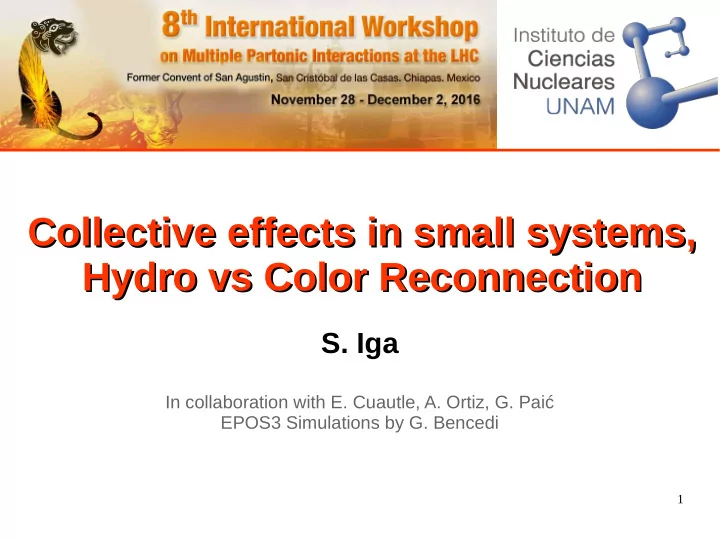

Collective effects in small systems, Collective effects in small systems, Hydro vs Color Reconnection Hydro vs Color Reconnection S. Iga In collaboration with E. Cuautle, A. Ortiz, G. Paić EPOS3 Simulations by G. Bencedi 1
Motivations Motivations 2
Recent results of flow in pp Recent results of flow in pp Collective effects in are A-A well known, p-p and p-A under discussion. CMS experiment has measured v 2 and v 3 Fourier coefficients associated to elliptic and triangular flow respectively in long range di-hadron correlations in function of multiplicity in pp collisions . Results show the same behavior observed in p-Pb and Pb-Pb Higher mult → higher flow-associated coefficient for the three systems ! 3 arXiv:1606.06198 [nucl-ex]
Models of CR included in Pythia 8 Models of CR included in Pythia 8 • The original PYTHIA (mode 0) • The partons of a lower-p T MPI system are merged with the ones in a higher-p T MPI • New scheme (mode 1) • The QCD color rules are incorporated in the color reconnection, and determine the probability that a reconnection is allowed • Gluon motion (mode 2) • Partons can be moved from one location to another so as to reduce the total string length 4 http://home.thep.lu.se/Pythia/pythia82html/ColourReconnection.html
CR shows flow-like patterns with CR shows flow-like patterns with CR mode0 CR mode0 The probability of two MPI systems to reconnect is given by P(CR) = (p T0 x CRR ) 2 / ( (p T0 x CRR ) 2 + p T 2 ) p T0 is energy dependence parameter CRR is the CR Range, parameter that you can choose between 0(No CR) and 10(Highest CR probability) And p T is the transverse momentum of the MPI system that wants to reconnect http://home.thep.lu.se/Pythia/pythia82html/ColourReconnection.html Higher nMPIs events shows a shift of the max value of p to pi ratio, more nMPIs leads to more CR effects. 5 10.1103/PhysRevLett.111.042001
Is it necessary to use hydro to Is it necessary to use hydro to explain the evolution of small explain the evolution of small systems ? systems ? Comparison between Hydro Comparison between Hydro (EPOS3) and CR (PYTHIA8) (EPOS3) and CR (PYTHIA8) models models 6
The p T spectra: Hydro vs CR Hydro vs CR The p T spectra: z = N ch / <N ch > PYTHIA8(Defaul CR mode0) harder than EPOS3 → high mult and MB , opposite in low mult 7
Multiplicity dependence of CR Multiplicity dependence of CR effects on p T spectra effects on p T spectra Higher mult. → Higher nMPIs CR effects → Grow with mult. and p T Bump around ~2.5GeV/c Seems to saturate for the highest mult. bin 8
Multiplicity dependence of Hydro Multiplicity dependence of Hydro effects on p T spectra effects on p T spectra Bump around ~2.5GeV/c too !! The effect diminishes at higher p T with hydro but not with CR 9
p p T spectra: Data vs models Data vs models T spectra: Data from 10.1140/epjc/s10052-013-2662-9 Hydro and CR describes well low p T region. Effects of hydro diminish at p T higher than 10 ~2.5GeV, CR still survives and seem to describes well the data inside the systematics
p p T spectra: Data vs CR models T spectra: Data vs CR models Data from 10.1140/epjc/s10052-013-2662-9 We can see that CR mode0 (Default) is the best describing the data 11
p T spectra: Data vs CR Ranges p T spectra: Data vs CR Ranges Data from 10.1140/epjc/s10052-013-2662-9 With CR-mode0 (Default) but changing the CR Range to a slightly higher value than the default fits better the data 12
<p T > vs N ch <p T > vs N ch Should the CR Range moves with the number of MPI of the event instead of being a constant ?? |η|<0.8 CR Range 1.0 fits the data inside the EPOS LHC seems to fit very well systematics in all N ch region but the this observable default value fits arround <Nch> 10.1016/j.physletb.2013.10.054 13 Region
Summary Summary ● We show that two very different approaches, hydro and CR, give almost the same results at p T lower than ~3 GeV/c ● At higher p T the QCD approach describes better the data complemented with a single final state parameter (CR) ● The default mode of CR is clearly favored compared with other models ● The possibility to modify the CR Range in function of the number of MPI (less for high nMPI, more for low nMPI) could improve the model. THE QUESTION THE QUESTION What changes from p-p to Pb-Pb ? 14
Thank you ! Thank you ! Enjoy Chiapas Enjoy Chiapas 15
Recommend
More recommend